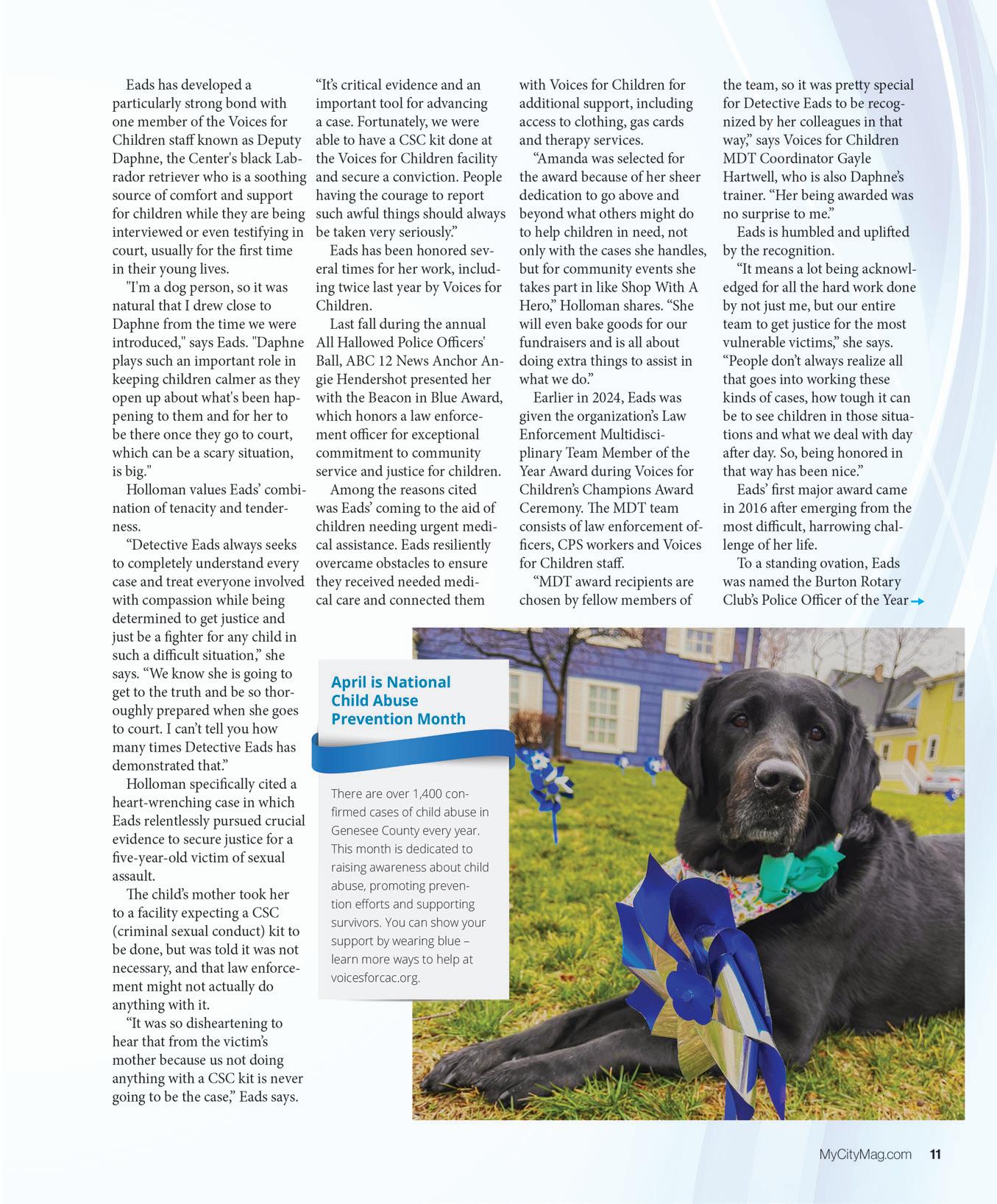










Dear Readers,
Ready or not … April means it’s o cially Home & Garden season!
Some of my neighbors on Lake Fenton have had their docks in the water for a month already – am I slacking, or are they just overly eager? As I write this, snow is blowing sideways outside my window (on the rst day of spring, no less). Yesterday, it was 71 degrees. Michigan, you never fail to keep us on our toes!
But we all know the drill: complaining about the weather is really just a way to pass time until we can fully enjoy Michigan’s great outdoors. And with warmer days ahead, it’s time to dive into home projects, freshen up our living spaces, and get those gardens growing. Our annual Home & Garden section has some inspiration and expert advice, including a look at the beautiful Applewood Estate as they prepare for another season of welcoming visitors (p.18). If you haven’t explored this historic gem, you’re missing out!
Also in this issue, we shine a light on Detective Amanda Eads, a true champion for children who has dedicated her career to helping young abuse victims nd justice. Her story, lled with resilience and dedication, is one you don’t want to miss (p.10).
For this month’s 7 Questions feature, I was happy to put my friend, Genesee County Drain Commissioner Je Wright, in the hot seat. If you’ve ever wondered what exactly a drain commissioner does (or just want to get to know a longtime community leader), ip to p.14.
And since living longer, healthier lives is always on our minds, our Longevity section returns with valuable insights – including an article by my friend Dr. Je rey Rohr on a cutting-edge cancer treatment being studied in Honduras. We also highlight the importance of hydration (because let’s be honest, we could all drink more water).
As always, this month’s content is rounded out with Style and our great variety of contributed columns. Enjoy … and get outside when you can!
Thanks for reading,

Publisher & Editor in Chief

W. Shiawassee Ave. Fenton, MI 48430
810.629.8000
Publisher & Editor In Chief
Vince Lorraine
Vince@mycitymag.com
Managing Editor
Sherron Barden
Sta Writer
Cheryl Dennison
Freelance Writer
Mark Spezia
Contributing Writers
Dr. Christopher Douglas
Vera Hogan
Alexandria Nolan-Miller
Nicholas R. Robinson, Esq.
Leslie Toldo
Shannon White
Graphic Designer Hailey Carriger
Contributing Artist
Daria Akulova
Accounting/Circulation
Kim Davis
Account Executive
Terese Allen
COVER ART Provided by Applewood
My City Magazine, Inc. 14165 Fenton Rd., Fenton, MI 48430 810.230.1783
©2025 My City Magazine, Inc. All rights reserved. Printed in U.S.A. MyCityMag.com
ISSN#1559-3436 is published monthly by My City Magazine, Inc., 14165 Fenton Rd. Fenton, MI 48430. Canadian Mail Agreement #41971515. For back issues, inquire for availability. Editorial Correspondence: Address product information and inquiries to: Editorial Department, My City Magazine, 14165 Fenton Rd., Fenton, MI 48430, phone 810.230.1783. To authors, photographers and people featured in this publication: All materials, articles, reports and photographs in this publication are the property of My City Magazine and cannot be used without written permission. The opinions and conclusions recited herein are those of the respective authors and not of My City Magazine. My City Magazine is not responsible for returning unsolicited manuscripts, photographs or other materials. Every effort will be made however, to return rejected manuscripts, etc., if they are accompanied by sufficient firstclass postage, but the Publisher will not be responsible for any loss of such material.












Compiled by Cheryl Dennison
Formost young adults, their 18th birthday is a milestone celebrated with newfound freedom, college applications or plans for the future. But for youth in foster care, that birthday can feel more like a cliff’s edge, according to Mindy Williams, President/CEO Whaley Children’s Center. Without family support, financial resources or stable housing, aging out of the foster care system is one of the most vulnerable transitions a young person can face. Recognizing this critical gap, Whaley Children’s Center launched its Independent Living Program – an initiative that provides aging-out foster youth with the guidance, stability and skills they need to succeed on their own.
“This program, long envisioned by the Leadership Team at Whaley, has now become a reality, and the impact is remarkable,” Williams reports. The Independent Living Program consists of two homes, each with six bedrooms, offering a safe, structured environment



WHALEY’S INDEPENDENT LIVING PROGRAM PROVIDES AGING-OUT FOSTER YOUTH WITH THE GUIDANCE, STABILITY AND SKILLS THEY NEED TO SUCCEED ON THEIR OWN.
where young adults can learn the skills necessary to navigate adulthood. The demand for such a program is evident – there is already a waiting list, highlighting the urgent need for expanded resources for aging-out youth.
“Life for foster kids isn’t any different than for non-foster kids,” Williams shares. “They still need guidance, a safety net, and someone to help them as they take their first steps into adulthood. No one turns 18 and instantly knows how to live independently; it’s a process, and they deserve that same opportunity.”
ment of Whaley’s team. “This is exactly the outcome we have been hoping for,” says Missy Taylor, Director of Independent Living. “We want siblings to be together, and watching them thrive while pushing each other to be their best is one of the more rewarding parts of working in this program.”

The program provides support in areas such as budgeting, job readiness, higher education planning, meal preparation and household management. But beyond the practical skills, it offers something just as crucial: a sense of home. “The youth in this program aren’t just given a place to sleep; they are given a place to grow, make mistakes and learn in a safe environment.”
While the program is still growing, its success is undeniable. Whaley Children’s Center has provided a model of what independent living should look like for foster youth – one that understands that turning 18 doesn’t mean the need for support suddenly vanishes. Instead, it’s the beginning of a new chapter, one where these young adults have the tools and encouragement to build a future of their own. “I have been on the Whaley board for close to a decade and while I am proud of all the work getting done each day, I am most proud of
“We have made a lot of progress for this specific population of youth, but we are just getting started!”
Mindy Williams President/CEO Whaley Children’s Center
One of the most heartwarming successes of the Independent Living Program has been the reunion of twin siblings who had spent years apart in separate foster placements. Now, under the same roof, they can rebuild their bond while working toward their individual goals. Their story is a testament to the power of stability, opportunity, and the unwavering commit-
being part of an agency that promotes ongoing care for foster youth. For Whaley kids, this program is a game-changer,” says Board of Directors Chairperson, Nadeem Gebrael. As the program continues to evolve, Whaley remains dedicated to expanding its reach and ensuring that every foster youth who ages out of the system has a place to turn. Because at Whaley, independence doesn’t mean going it alone – it means having the support needed to truly thrive.


















TheManors at Pine Hollow provides a rare opportunity to enjoy luxurious living amidst nature, in a tranquil and private setting. In this final phase of Pine Hollow – The Manors – homes are set across 36 acres, offering stunning views of serene ponds, rolling hills and over 200 acres of meticulously landscaped common areas. Surrounded by nature and expansive views, this environment delivers a sense of calm and serenity.
The Manors at Pine Hollow combines privacy, exclusivity and convenience, right in the heart of Grand Blanc. With easy access to I-75 and US-23, and close proximity to Bishop International Airport, travel is effortless. Exceptional healthcare is nearby, including Henry Ford Genesys Hospital, McLaren Health Care, and Hurley Medical Center, ensuring top-tier care is always close. Families benefit from access to Grand Blanc Public Schools,

At The Manors, enjoy the beauty of nature and the convenience of nearby amenities, all within an exclusive Grand Blanc community. It’s a refined, elevated way of living that blends tranquility with accessibility, making it the perfect choice for those seeking both privacy and luxury. With Grand Blanc’s ever-growing list of amenities and close-knit community feel, this location offers the best of both worlds – peaceful living with easy access to everything you need.
the top public school system in Genesee County. Discover the perfect balance of luxury and convenience at The Manors.
With expansive views of nature, rolling hills and beautifully landscaped commons, The Manors at Pine Hollow offers a peaceful, private retreat. Residents can immerse themselves in a naturally beautiful, serene environment to escape the bustling activities of daily life.
Those considering The Manors at Pine Hollow are encouraged to experience it


firsthand with a complimentary tour highlighting the features that make the development truly exceptional. During your visit, you’ll have the opportunity to meet the new ownership – a distinguished partnership between developer Prestige Properties and the award-winning exclusive builder, Signet Residential, serving the community since 1991. Their combined expertise covers everything from site selection, floorplan creation and architectural design guidance to professional project planning and development. Both Prestige and Signet are dedicated to crafting the finest luxury properties and custom-built homes. With a legacy of excellence and a commitment to quality, The Manors at Pine Hollow offers more than just a place to live – it offers a lifestyle tailored to those who appreciate fine craftsmanship and thoughtful design. Whether you’re seeking a dream home or an investment in unparalleled luxury, this community embodies the perfect blend of expertise and timeless elegance. Discover firsthand what makes The Manors at Pine Hollow a truly exceptional place to call home. Call 810.695.9901 to schedule your tour today!
BY JENNIFER LASCO, REALTOR/REAL ESTATE BROKER

asked to describe the real estate market over the last few years in one word, “challenging” sums it up nicely. We have watched the inventory shrink, the prices remain strong and stable, and the mortgage interest rates hit over 7%. We have watched buyers and sellers drop out of the market, waiting to see where the crazy post-COVID economy would take us. If ever there was a time when a professional realtor could be the di erence between success and failure, that time is now.
Whether you’re a buyer or a seller, 2025 is the balanced market of opportunity we have all been waiting for. The new year has brought a much more favorable inventory than we have seen in years, and lower interest rates are the icing on the cake. If you’ve been thinking about a move, I have some tips to get you from where you are to where you want to be.
e rst and most crucial step is to understand your nancial position. An experienced agent can help assess your home’s condition and current market value. A walk-through can help determine whether your home
is “show-ready” or if a bit of furniture staging or updates could increase its value.
In addition to showing you how your home stacks up against comparable properties and suggesting a listing price, your CMA valuation can also be used to calculate your approximate net proceeds after closing costs and what funds you will have available to use for your next home purchase.
Once you have determined your nancial position and have a clear idea of where you’d like to relocate, your realtor can help recommend quali ed lenders that o er the most bene cial types of loans. Di erent nancing options may be available in the city or a more rural setting, just like for a detached single-family home or a condo. Understanding nancing options can make a world of difference in terms of convenience. For example, a bridge loan allows you to buy your new home before selling your current one – no need to worry about matching up contract timelines and you can move when it is most convenient.
Once you have a solid grasp of your nancial picture, you are ready to prepare your home to list.
1. Before listing, address any necessary repairs. A prospective buyer will notice surface-level issues during a showing and submit a lower o er; if repair items are more signi cant and possibly less visible, they will come up during the inspection. Completing repairs beforehand allows for a smooth transaction and ultimately, more money in your pocket.
2. Professional photography is a must! Buyers fall in love with your home online before they see it, so make sure the photos show it in the best light.
3. Base your price on market comps, not emotion. When you price yourself out of the market and your home sits, you will lose much more in the end. Your price can be strong and competitive, yet still realistic.
4. Create space – clutter, oversized furniture, full cabinets and closets make your house feel much smaller than it is.
5. Deep-cleaning is o en overlooked, but so very necessary. If you don’t have the time, your agent can recommend a company to come in and help.
1. Get a current pre-quali cation from a lender – knowing what you are comfortable spending is imperative for making quick moves in a fast market.
2. Negotiate wisely. A skilled agent can o er non-monetary options to help create a compromise and cra an unbeatable o er.
3. Keep your mind open to options outside your idea of the perfect property; people are o en surprised to fall in love with a home they hadn’t envisioned. An experienced agent can present unexpected options that could be an ideal t.
Whether the time is now, next month or in a few years, consult with an agent who will keep you in the know with property and market updates a few times a year. Realtors have great tools to share and are always glad to help.




Afamily-owned business for nearly 80 years, Linden Kitchen & Bath is a trusted and respected name in the home remodeling industry. “We take great pride in o ering exceptional kitchen and bath remodels with a personal touch,” states Owner/Designer, Michelle Robins. “Over the decades, we’ve not only built lasting relationships with our customers but also stayed ahead of design trends, ensuring we create spaces that combine timeless elegance with modern style.”
As we move into 2025, design trends are shi ing toward sustainable, functional spaces with a focus on natural materials, minimalist aesthetics and smart technology. Kitchen designs are featuring warm, earthy tones combined with cutting-edge technology and eco-friendly materials. Smart kitchens are becoming standard, integrating smart appliances, intuitive lighting and e cient layouts.
In bathrooms, the trend is leaning toward spa-like environments with natural stone surfaces, open shelving and water-saving xtures. Energy-e cient designs are key, making sustainability a central


theme in every remodel. “Whether updating your kitchen with modern nishes or transforming your bathroom into a serene retreat, we’re here to help you create a space that ts both your lifestyle and the latest trends,” says Robins.




“Whether you envision a sleek, modern kitchen or a tranquil bathroom with natural nishes, we have the expertise to bring your vision to life.” From consultation to nal touches, the team works closely with clients to ensure a smooth, stress-free process, making sure their project aligns with today’s design trends and their personal preferences. “Our commitment to quality, cra smanship and customer satisfaction has made us a leader in the remodeling industry.”
“We specialize in complete kitchen and bathroom remodels,” adds Robins. “At Linden Kitchen and Bath, your project begins with a detailed consulta-
tion to discuss your needs, ideas and budget, allowing us to tailor the design to suit your aesthetic style and functional requirements.” Close collaboration helps the team create a custom design, using only the highest-quality materials and craftsmanship. “We manage every aspect of the project, from demolition to installation, keeping you informed every step of the way. Our personal, hands-on approach sets us apart.”
At Linden Kitchen & Bath, a focus on building lasting relationships with clients ensures that they feel con dent and excited throughout the remodeling process. “ is approach has earned us the trust of countless customers,” Robins shares. “Despite our growth, we’ve remained true to our core values. We understand that your kitchen and bathroom are the heart of your home, and we treat every project with the care and dedication it deserves. is dedication is the foundation of our success.”
To give each project the attention it deserves, consultations are by appointment only. “Whether you’re considering a remodel or ready to begin, we’re here to help,” says Robins. “Contact Linden Kitchen & Bath today to schedule your appointment and start creating the kitchen or bathroom of your dreams!”

COMPILED BY SHERRON BARDEN
ecycling and salvage play a crucial role in reducing waste and repurposing valuable materials, but many people don’t fully understand the di erence between the two. Jim Dimarco, Owner of Scrap Dog Recycling & Salvage, explains how the industry works, common misconceptions and the most valuable discarded materials.
SALVAGE VS. RECYCLING: WHAT’S THE DIFFERENCE?
Salvage involves reusing parts from a vehicle or other metal-related items, while recycling is the process of breaking down materials to create new products. “Most of what we recycle has some type of metal content,” says Dimarco. In addition to metals, Scrap Dog also processes paper waste for commercial clients, such as printing companies with high-volume paper disposal needs.
CLEARING UP MISCONCEPTIONS
While metal recycling and salvage yards are fairly straightforward, Dimarco points to
confusion surrounding curbside recycling. “Many people think curbside recycling goes into a land ll with the trash, which is not the case,” he explains. “It’s collected by a separate truck – similar in appearance to a trash truck – but it then is transported to a recycling facility where materials are sorted and sent to mills for repurposing.”
Despite uctuations in various industries, Dimarco sees stability in recycling and salvage. “Recycling and salvage have been around forever, and not much has changed other than the way materials are processed with new technology.” While trends in recyclables remain steady, he has noticed an increase in awareness. “More people are recycling and they understand how it works. We’ve even created a section on our website showing people what items in di erent areas of their homes can be recycled, which has been bene cial for them and for us.”
steel, are more common but have less value,” Dimarco notes. How to tell the di erence? “A magnet will stick to ferrous metals but not to non-ferrous ones.”
WHAT
While many metals and electronic components can be recycled, there are materials that require specialized disposal. “Old tube TVs and computer monitors contain toxic components and need to be handled by specialized recyclers,” says Dimarco. Scrap Dog Recycling
“More people are recycling and they understand how it works.”
Jim Dimarco, Owner Scrap Dog Recycling & Salvage
& Salvage simpli es the process with a clear motto: “If it has a cord attached, an engine or motor inside of it, takes batteries, or contains a majority of metal content – WE BUY IT!”
Some of the most valuable items people discard include non-ferrous metals such as copper, brass, aluminum, catalytic converters and lead. “Ferrous items, which are made of

Recycling and salvage remain essential in reducing waste and reusing valuable materials. By understanding the process and knowing what can be repurposed, individuals can make informed decisions and contribute to a more sustainable future.

COMPILED BY SHERRON BARDEN
That charming old house might have beautiful hardwood oors and a cozy replace, but what about the hidden surprises – like a family of squirrels in the attic or plumbing that last worked properly in the ‘90s? A home inspection is like a rst date for your house – it reveals the good, the bad, and the “you might want to run!” Whether you’re buying, selling or just making sure your home isn’t hiding any expensive secrets, here’s why a thorough inspection is worth every penny.
We asked David Worrell, Owner of HomeTeam Inspection Service of Fenton MI, about the inspection process, what inspectors look for and why skipping an inspection could be a costly mistake.
A: First, the purpose of a home inspection is to provide the buyer with information about the home’s condition in order to help them with their decision-making process – to nd material defects, safety concerns and needed repair issues that will cost greater than $1,000.
Key focus areas include components that the buyer cannot easily see, such as attics, crawlspaces, roof condition and electrical panels. Structural and foundation issues are also crucial. Inspectors also pay close attention to safety items like secure exterior doors and windows, smoke and carbon monoxide detectors, and ground fault interrupter circuits (GFCI) near water sources.
A: A home inspection is a visual inspection – the most important tools for inspectors are their training and their senses, and knowing what to look for is important. HomeTeam inspectors utilize thermal imaging and moisture meters to detect potential issues, as well as drones when roof or chimney access is limited. Our inspectors can perform camera inspections of sewers and also use receptacle testers, gas detectors, carbon monoxide detectors and smaller cameras.
Q: WHAT ARE THE COMMON MISCONCEPTIONS ABOUT HOME INSPECTIONS?


A: e most common misconception is that a home inspection is a guarantee or warranty. It is a visual inspection of the conditions of the property at the time the inspection is performed. e goal is to provide a prospective buyer with information about the home that will help them make an informed decision.
“THE GOAL IS TO PROVIDE A PROSPECTIVE BUYER WITH INFORMATION ABOUT THE HOME THAT WILL HELP THEM MAKE AN INFORMED DECISION.”
Another misconception is that inspectors can see through walls or any other obstacles. Inspectors should not be expected to move furnishings or take a house apart to see behind obstructions. e buyer does not yet own the home and does not own the furnishings in the home. e inspector should not be performing tasks that may damage the home or furnishings.
It’s
no secret: buying a home is one of the most signi cant investments a person can

BASE HOME INSPECTION • COMMERCIAL INSPECTION • PEST INSPECTION
RADON TESTING • SEWER SCOPE
WATER TESTING • WELL & SEPTIC
INSPECTIONS • AIR QUALITY TESTING
MOLD SAMPLING • MANUFACTURED HOME CERTIFICATIONS
make, and a home inspection is a crucial step in ensuring that investment is a sound one. Skipping this step might save a little money upfront, but the potential costs of unexpected repairs or safety hazards could far exceed that savings. A thorough home inspection provides buyers with peace of mind and the information they need to make con dent, informed decisions about their investment.

BY SHERRON BARDEN

TheMichigan Green Schools Program supports and celebrates the achievements of PreK-12 schools in protecting the state’s air, land, water and ecosystems through their commitments to environmental education and stewardship actions. For the 2023-2024 school year, 343 schools were designated as Michigan Green Schools. Wow!
By participating in the program, these schools are implementing sustainability initiatives that bene t both their campuses and communities. Two local high schools that are leading the charge and taking action to protect the environment were proud to share some of their achievements.
FHS Eco Club Advisor, Nicholaus Je rey told My City about the school’s involvement in the Michigan Green Schools program.
“FHS is making a lasting impact through its commitment to sustainability and environmental initiatives,” says Je rey. “As part of the Michigan Green Schools program, the club focuses on recycling, composting and community beauti cation e orts that bene t both the school and the wider community.”
A Commitment to Recycling & Beautification
ree years ago, the FHS Eco Club launched a recycling program for returnable plastic and metal drink containers, preventing 300500 cans and bottles from ending up in land lls each week. “ e students see all the recycled bottles in the collection buckets – it’s a lot –
Earning Green Schools Certification
Beyond recycling, the Eco Club has implemented composting of kitchen greens, organized educational activities for rst-graders during Pond Day, and conducted trash pickups both on and o campus. Every FHS student plays a role in these by using

EARTH DAY 2025 WILL BE CELEBRATED ON APRIL 22!
and they realize we can make a di erence,” adds Je rey. e funds raised from these e orts support other initiatives, such as beautifying the medians between FHS and AGS Middle School and assisting with the Fenton Community Garden by moving mulch, installing fences and maintaining the plots.
classroom
bins, bene ting from motion-sensor lighting, and accessing the digital version of the school newspaper rather than printed copies.
Looking ahead, the club aims to partner with conservation
organizations across Michigan, acquire a greenhouse for the high school, and expand composting e orts while reducing single-use plastics. “We would like to look into reusable trays and utensils for the lunchroom, but we will need a lot of support from the school and outside assistance to make it happen,” Je rey explains.
e Club’s work has already in uenced student behavior, with a noticeable decline in single-use plastic water bottles at school. eir next goal is to eliminate them entirely by providing students with reusable alternatives. Additionally, composting e orts have signi cantly reduced waste, with the collected compost being used to nourish the Fenton Community Garden. “We are always nding more opportunities for the students to help our community be more green,” says Je rey. With ongoing initiatives and new sustainability goals on the horizon, the FHS Eco Club continues to make a meaningful impact on both students and the environment.
On March 11, DHS Environmental Science Instructor and Environmental Club Advisor, Pamela Ruggiero, was proud to learn that the school was approved for the Michigan Green Schools “Evergreen” status – the highest level – a er completing 20 or more required activities. Established in 2021, the DHS Environmental Club is going strong. “Students of all grades and abilities are welcome to join at any part of the year,” Ruggiero says. “ e Club is primarily responsible for many of our Green School qualifying activities.”
Here is a sample of the 23 activities DHS submitted to achieve their MGS status:
• Volunteers from the Environmental Club and the National Honor Society collect paper and plastic/aluminum bottles from the high school and Alternative Education school. Paper goes into a recycling bin; plastic and aluminum cans are sorted by cash value – non-returnables are recycled curbside by Ruggiero.
• Volunteers from Environmental Science classes collect organic waste from all three lunch times and deposit it in an outdoor compost bin. Built by the Construction Trades class, the bin is maintained by the Environmental Club and used for the school’s vegetable garden.
• To reduce waste of perfectly good food, volunteers from the Visual Arts classes have set up a give-and-take table, allowing students to share uneaten items that meet the National School Lunch Program’s requirements for a free lunch.
• e Food Services Department donated and had installed a greenhouse for the Environmental Club to grow (from seed) ingredients for pico-de-gallo to be served on the cafeteria’s nacho/burrito bar
– tomatoes, onions, cilantro, peppers. Plans are in the works to expand what is grown for use in the school cafeteria.
• Environmental Science, Visual Arts and Environmental Club students are caretakers of a very large Native Plant Garden created to increase biodiversity. e garden is also located near an outdoor classroom space, so all students can use the space to learn about how the garden helps biodiversity. Students are creating signs describing each of the plants.
• Students in the Construction Trades class built bat houses, an owl box and about a dozen bluebird boxes, all of which are placed around the DHS campus.
• Environmental Science students participate in Flint River GREEN (Global River Environmental Education Network), a citizen science project for middle and high school students. Teachers take students to local streams to test water quality, measuring pH, phosphates, nitrates, dissolved oxygen, turbidity and fecal coliform levels. e collected data is shared with local municipalities, including the Genesee County Drain Commission. is hands-on experience engages students in real-world science aligned with Next Generation Science Standards, while government o cials use the data to support water management e orts.
Appropriately, Pamela Ruggiero closed her submission to My City with a Native American proverb: “We have not inherited the Earth from our forefathers, we are borrowing it from our children.”
For more about Michigan Green Schools, visit michigan.gov/egle/public/ egle-classroom/michigan-green-schools.



BY SHERRON BARDEN
Imagine stepping into your garden on a summer morning, the air alive with the soft buzz of bees, the flash of a butterfly’s wings catching the light, and a hummingbird hovering gracefully over a cluster of blooms. More than a delight to watch, these tiny visitors are working hard to keep our ecosystems and food supply thriving.
Pollinators come in all shapes and sizes –from bees and butter ies to hummingbirds, bats and even beetles. ey play a crucial role in the reproduction of owering plants, contributing more than $20 billion in direct services to the agricultural industry. Without them, many of our favorite fruits, veggies and owers wouldn’t survive. Yet, pollinator
populations are declining, due in large part to habitat loss and pesticides. But here’s good news: Your garden can be part of the solution!
e easiest way to support pollinators is by making your outdoor space more welcoming. Start with these simple steps:
Plant with Purpose – Choose a variety of native plants that bloom from early spring to late fall. Clusters of owers are easier for pollinators to nd than single plants scattered throughout a garden. Avoid hybrids, which may be beautiful but o en lack the nectar and pollen that pollinators need.
Think Beyond Flowers – If you love butter ies, don’t forget their caterpillar stage! Providing host plants ensures the full butter y life cycle happens right in your yard. Monarch caterpillars, for example, rely on milkweed. Since they will be munched on, you can position some of these plants in less visible areas of your yard.
Ditch the Chemicals – If you must use pesticides and insecticides, opt for organic alternatives and apply them when pollinators are less active. Be especially wary of systemic insecticides, which can poison pollen and nectar.
More Green, Less Grass – Swap out some of your lawn for owering plants, shrubs, or even a small wild ower meadow. Every patch of greenery helps provide habitat and food.
Want to roll out the red carpet for pollinators? Here are some of their faves:
Bluebeard (Caryopteris)
Loved by late-season pollinators
Cape Fuchsia (Phygelius)
A hummingbird favorite



Cone ower (Echinacea)
A summer staple that attracts bees & butterflies

Goldenrod (Solidago) Supports a wide variety of pollinators
Milkweed (Asclepias) Essential for monarch butterflies
Stonecrop (Sedum)
A late-season favorite for bees & butterflies
Yarrow (Achillea) Easy to grow, great for bees
One of the most beloved pollinators, monarch butter ies migrate thousands of miles every year, with many spending their summers in Michigan and winters in Mexico. Unfortunately, due to habitat loss and pesticide use, their population has dropped by 90%.
(about 4% of the space) and avoiding harmful chemicals.
Fun Pollinator Facts
From the U.S. Fish & Wildlife Service
• Hummingbirds love tubular, brightly colored owers with deep nectar.
• Butter ies and moths spread pollen, but they don’t have special structures for collecting it.
• Beetles pollinate more than 80% of owers – though they’re clumsy iers!
• Bats pollinate over 300 types of fruit in tropical and desert climates.
Want to do more? Mark your calendar for Pollinator Week 2025 (June 16-22) – a great time to learn, plant and share the importance of these vital creatures. With a little careful planning, you can turn your garden into a thriving oasis for pollinators. In return, you’ll enjoy a healthier, more vibrant outdoor space, abundant owers and a deeper connection to the marvelous natural world buzzing all around you.


SAVOR THE SHADE
BY SHERRON BARDEN
Move over, bold brights and cool neutrals – 2025 is bringing warmth, richness and a touch of indulgence with PANTONE 17-1230 Mocha Mousse! This deliciously deep brown is like a comforting cup of cocoa, a velvety espresso or that perfect bite of chocolate cake. In other words, it’s a shade that soothes the soul while keeping things effortlessly sophisticated.

According to Leatrice Eiseman, Executive Director of the Pantone Color Institute, Mocha Mousse represents “thoughtful indulgence – a color that’s both grounding and aspirational, classic yet lush.” ink of it as the ultimate cozy-chic hue, blending timeless elegance with the simple joys of everyday life.
36 April 2025
WHAT MAKES MOCHA MOUSSE SPECIAL? is mellow brown is more than just a pretty shade – it’s a whole vibe:
• Comfort & Wellness – A hue that wraps you in a sense of coziness, stability and emotional balance.
• A Connection to Nature – Inspired by earth, wood, co ee and all things warm and natural.
• Harmony & Simplicity – Not here to steal the show, but to create a calming, grounding presence in any space.
HOW TO USE MOCHA MOUSSE IN DESIGN is versatile shade plays well with just about anything. Use it for accent walls, plush furniture or warm-toned ooring for a sophisticated, yet inviting space.
MOCHA MOUSSE 17-1230
MOCHA MOUSSE SHINES WHEN PAIRED WITH:
• Neutrals – Ivory, beige and so grays for a re ned, classic look.
• Metallics – Gold or copper to bring out its rich, luxurious side.
• Pops of Color – Coral pink, teal or even a deep, forest green for a bold contrast.
PANTONE has been setting the color trends since 1999, when Sky Blue rst kicked o the Color of the Year tradition. Now, with Mocha Mousse taking center stage, 2025 is shaping up to be all about warmth, comfort and timeless elegance. So go ahead – embrace the brown! Whether you’re painting a wall, updating your wardrobe or just sipping on a latte in its honor, Mocha Mousse is here to make the year a little richer, a little cozier, and undeniably stylish.






COMPILED BY KAREN
PIACENTINI, OWNER OF FENTON’S OPEN BOOK
Whether you have a sprawling backyard, a few raised garden beds or just a sunny windowsill, these books will help you grow something amazing! From keeping critters out of your landscaping to teaching kids about plants, this list has a little greenthumb inspiration for everyone.
• Deerproofing Your Yard & Garden by Rhonda Massingham Hart
• Square Foot Gardening | by Mel Bartholomew
• Foraging with Kids | by Adele Nozedar
• Gardening for Everyone | by Julia Watkins
• Grow Cook Eat: A Food-Lovers Guide to Vegetable Gardening | by Willi Galloway
• Mini-Farming for Beginners | by Brenda Sanders
• Raised-bed Gardening for Beginners | by Tammy Wylie
So, grab your gardening gloves and let’s get growing!




Inthis section, we explore a variety of facets of living well – for as long as possible. From cutting-edge cancer research in Honduras to the everyday importance of staying hydrated, we’re diving into the science and daily habits that support a healthier, longer life. We’ll examine the toll stress can take on our bodies and how home health care can help us maintain independence in our later years. And when it’s time to plan for the future, a local funeral home has insights on cremation services. Because longevity isn’t just about adding years … it’s about making every year count.







BY STACY SAWYER HAMILTON COMMUNITY HEALTH NETWORK
However, research suggests that people who take proactive steps to manage stress – such as regular exercise, mindfulness practices, and strong social connections – tend to live longer and enjoy better overall health. Beyond lifestyle changes, access to quality healthcare plays a major role in identifying and addressing stress-related health concerns before they become more serious.
The Role of Primary & Behavioral Healthcare in Stress Management
Many people don’t consider stress management a medical concern, but regular visits to a primary care provider (PCP) can be essential in catching stress-related symptoms early. During routine check-ups, providers can assess how stress is a ecting a patient’s physical health, o ering guidance on sleep, nutrition and mental wellness.
Stress is a natural part of life, but when it becomes chronic, it can take a serious toll on both physical and mental health. Studies have shown that prolonged stress contributes to heart disease, high blood pressure, weakened immune function and even premature aging. While eliminating stress entirely may not be possible, learning how to manage it e ectively can signicantly improve quality of life and increase longevity.
“Stress impacts every aspect of a person’s well-being – physically, emotionally and mentally. When we help individuals recognize and manage stress, we’re not just improving their daily lives, we’re
increasing their chances of a longer, healthier future,” says Albert Ujkaj, MBA, LMSW, Director of Behavioral Health at Hamilton Community Health Network.
Understanding the Link Between Stress & Health
e body’s natural response to stress is the release of hormones like cortisol and adrenaline, which prepare us to react quickly in challenging situations. While this response is useful in short bursts, chronic activation of the stress response can lead to long-term damage, increasing the risk of anxiety, depression, digestive problems and cardiovascular disease.
health, Hamilton Community Health Network o ers “Healthy Mind, Healthy Body”, a monthly mental wellness discussion designed to help individuals navigate stress and prioritize their mental health.
ese free, one-hour sessions take place on the second Friday of each month from 1- 2PM at our North Pointe Clinic on Clio Rd. in Flint. Open to the public, including both patients and non-patients – each discussion provides an opportunity to engage with healthcare professionals, share experiences and learn practical strategies for improving mental wellness. Attendees can also win prizes, making participation even more rewarding.
In addition to primary care, behavioral health services can help people develop coping strategies tailored to their needs. At Hamilton, our integrated approach ensures that patients receive holistic care, with PCPs and behavioral health professionals working together to address the root causes of stress.
“Early intervention is key – catching and addressing stress-related health issues before they develop into chronic conditions can add years to a person’s life,” explains Ujkaj. “If you’re stressed, worried, sad or even happy, your mental wellness should always be a top priority.”
Because emotional well-being is just as important as physical
“Chronic stress can have a profound impact on both physical and mental health,” Ujkaj emphasizes. “When patients engage in regular wellness exams, behavioral health conversations and primary care visits, they’re not just addressing immediate concerns; they’re building a foundation for long-term resilience and well-being.”
Proactive
to Living Longer and Healthier Stress may be unavoidable, but its e ects don’t have to dictate your long-term health. Taking a proactive approach –through regular healthcare visits, engaging in behavioral health conversations and utilizing community resources like “Healthy Mind, Healthy Body” – can help individuals manage stress more e ectively and protect their well-being for years to come. By making preventive care a priority and seeking support when needed, you can not only reduce your risk of stress-related illnesses but also build a healthier, more ful lling life.

Helping Hand Nursing Service Home Health Care, LLC is a private-duty home care company serving the aging population throughout Michigan. Based in Grand Blanc, the family-owned company has over 50 years of combined experience in the home health care industry. Helping Hand takes pride in providing quality and compassionate care to those who need assistance with daily activities that become a little more difficult with age.
“Our services allow our clients to remain in the comfort of their own home longer and provide peace of mind to family, so they know their loved one’s needs are met with dignity and respect when they’re unable to be there,” states Erika Wheeler, CEO. “We offer services that are flexible and designed to fit the specific needs of each individual.” Whether someone is in need of assistance with personal care, meal preparation, medication reminders, nursing care or simply companionship, Helping Hand caregivers have
you covered. “Our experience and longstanding relationships with organizations throughout the communities we serve allow us to provide services to a variety of clients such as veterans, auto accident survivors, and those suffering from diseases such as Alzheimer’s and Parkinson’s,” she adds.
Often, families wait until something life-altering has happened before they seek assistance from private home care. “The best time to introduce our services to a loved one is before an unexpected event occurs – one that may have been prevented with regular check-ins from our caregivers,” Wheeler says.
With Helping Hand Nursing Service, care meets comfort at home. “Let us be your peace of mind with home care services you can trust.”


For many people, the process of cremating a loved one is a mystery. At Swartz Funeral Home, our ten-step process guarantees that your loved one is well cared for at all times.
1. CODE OF ETHICS
We adhere to a strict code of ethics and procedures while your loved one is in our care. We only use Genesee Cremation Center, a member of the Cremation Association of North America, who we know and trust to uphold these ethical standards.
2. SAFEGUARDING PERSONAL IDENTITY
A personal I.D. tag is placed on your loved one the moment they are transferred into our care.
3. UNIQUE TRACKING SYSTEM
Upon arrival at the crematory, your loved one is logged into a tracking system and assigned an I.D. number, which is stamped into a stainless steel tag to track every phase of the cremation process.
4. FAMILY IDENTIFICATION
Our staff properly encases your loved one in the cremation container selected; then, we verify identity by comparing I.D. bands from the hospital or nursing home. In the case of a death at the family home, positive I.D. occurs when we arrive at the residence.
5. CHECKS & BALANCES
A crematory technician and licensed funeral director reviews all cremation paperwork and permits. Once all documentation is verified, the technician starts the cremation process.
6. CREMATION LOG BOOK
Immediately prior to the cremation process, your loved one is taken to the crematory and their personal I.D. is logged containing the name, date, I.D. number and crematory operator’s name. It is dated and initialed by a cremation technician before and after the cremation.
7. DURING THE CREMATION
The crematory checklist and I.D. card are placed on the outside of the cremation chamber during the cremation process. The metal I.D. tag is present in the cremation chamber during the process.
8. POST-CREMATION DETAILS
After cremation is complete, the remains are placed with the stainless steel I.D. tag into an urn. The I.D. card and cremation certificate are placed into our permanent files.
9. RETURN OF REMAINS
Our staff will notify you to schedule a time for picking up the cremated remains.
10. CELEBRATION OF LIFE
To appropriately celebrate the life of your loved one, we assist you in planning a funeral or memorial service either before or after the cremation.
We are happy to answer any other questions you may have about our cremation process, and the commitment we have to every family we serve.


BY DR. SHAN JACKSON
Aswe age, maintaining hydration becomes a silent yet powerful ally in the quest for longevity. Water and herbal teas are not merely thirst-quenchers; they are foundational to cellular health, detoxi cation and cognitive function. is article explores how these liquids contribute to healthy aging, backed by science and practical wisdom.
The Science of Hydration & Longevity
Hydration is critical for cellular homeostasis. Water facilitates nutrient transport, waste removal and joint lubrication. Dehydration strains organs, accelerates skin aging and impairs cognition. Studies, including a 2023 NIH report, link chronic dehydration to higher mortality risks, underscoring hydration’s role in extending health span.
Water
The Essence of Life
• Daily Needs: While the “8 glasses a day” is a guideline, individual needs vary. e National Institute on Aging recommends monitoring urine color (pale yellow indicates good hydration).
• Aging Challenges: In older adults, reduced thirst perception increases dehydration risk, leading to urinary tract infections and kidney strain. Reduced thirst perception begins as early as age 50. A 2022 study in the European Journal of Nutrition found that over

40% of adults aged 65+ are chronically dehydrated.
• In older adults, dehydration is linked to urinary tract infections (UTIs), kidney stones and delirium. e World Health Organization (WHO) reports that dehydration contributes to 20% of preventable hospitalizations in seniors.
Practical tips for improving hydration include setting reminders and consuming water-rich foods (e.g., cucumbers, berries).

By supporting cellular function, reducing oxidative stress and enhancing vitality, water and herbal teas are cornerstones of longevity.
Nature’s Elixir for Aging Well Herbal teas o er hydration paired with bioactive compounds:
• Chamomile: Rich in apigenin, an antioxidant promoting relaxation and reducing inammation.
• Hibiscus: High in anthocyanin, linked to lowered blood pressure and oxidative stress.

• Ginger: Anti-in ammatory properties aid digestion and Green Tea: Green tea contains ca eine, which can have mild diuretic e ects; but its polyphenols, especially EGCG, have been linked to cardiovascular health and longevity. Moderate consumption is ne for hydration.
NOTE: Herbal teas with minimal ca eine avoid diuretic e ects, making them ideal for hydration. Always consult a healthcare provider regarding herb-medication interactions.
• Studies, such as one from the NIH in 2023, found that optimal hydration lowered the risk of premature death by 20% compared to those with inadequate intake.
• Dehydration reduces blood volume, increasing cardiac strain. A 2021 study in e Journals of Gerontology linked chronic dehydration to a 30% higher risk of cardiovascular events in adults over 65.
• On a cellular level, dehydrated cells exhibit shortened telomeres, a biomarker of accelerated aging, according to a 2020 study in Proceedings of the National Academy of Sciences.
Combining water with herbal teas ensures diverse bene ts. For instance, morning hydration with water jumpstarts metabolism, while evening herbal teas promote relaxation without disrupting sleep. is synergy supports sustained hydration and nutrient intake.
• Flavor Infusions: Add citrus or mint to water for appeal.
• Routine Integration: Pair tea with meals or meditation.
• Monitor Intake: Use marked bottles to track consumption.

• Electrolyte Balance: Include broths or electrolyte-rich foods if needed, especially a er exercise.

In conclusion, hydration through water and herbal teas is a simple, e ective strategy for healthy aging. By supporting cellular function, reducing oxidative stress and enhancing vitality, these liquids are cornerstones of longevity. Embrace them as daily rituals to age gracefully and healthily.
Dr. Shan Jackson, Owner and CEO of Healthy Just Feels Right is a certified holistic mental health and wellness specialist, book author and motivational speaker. She has a passion for nutrition and loves to cook, develop recipes and write about health and wellness. Dr. Jackson aims to help individuals and families transition to a healthier lifestyle by incorporating more fresh foods into their diets. She believes that food can play an important role in managing chronic health issues, symptoms of depression and other mood disorders without using medications that can have harmful side e ects. To discover more creative and fun ways to inspire a healthier lifestyle, visit healthyjustfeelsright.com.
MyCityMag.com 51



GALAXY LANES | 2.20-23.2025
PHOTOS COURTESY OF BBBS
Thespirit of competition for a good cause permeated the atmosphere at this annual fundraising event raising crucial dollars necessary to achieve the BBBS mission of creating and supporting one-to-one mentoring relationships that ignite the power and promise of local youth. e event brought together community members for a night of fun and philanthropy in support of mentoring programs for local youth. is year’s theme was “Ignite the Rivalry … Defend Potential” with BBBS is encouraging businesses, organizations, schools and individuals to show their spirit and claim bragging rights – all while giving back to the youth of Flint & Genesee County.
And show up they did! During the four-day event, the alley became a hub of activity with over 188 teams of 4-5 bowlers. Participants ranged from local businesses to families, all motivated by both the fun of friendly competition and the good cause behind it.
Through pledges, sponsorships and 50/50 drawings, the event successfully raised over $116,000. These vital funds will support mentorship pairings, ensuring that young people in the community have strong, positive adult influences in their lives.
Filled with laughter, camaraderie and a shared purpose, the event underscored the di erence a united community can make. As bowlers packed up their shoes and alley lanes closed, plans were already brewing for next year’s event, with hopes of building upon this year’s spirit and success of having made a tangible di erence.




















BY DR. CHRISTOPHER DOUGLAS

TheTrump Administration’s “Department of Government E ciency” (DOGE) is making headlines for the substantial federal government layo s that have resulted from its cuts. e idea behind DOGE is not new. President Obama had the “National Commission on Fiscal Responsibility and Reform,” collegially known as the “Bowles-Simpson” commission a er its committee chairs, former White House Chief of Sta Erskine Bowles and former Wyoming Senator Alan Simpson. In December 2010, Bowles-Simpson proposed a series of budget cuts, reforms to Social Security and Medicare, and tax reforms to reduce the federal budget de cit. None of the commission’s recommendations were enacted.
President Clinton had the “Commission to Reinvent Government.” e goal was to streamline the federal government and achieve cost savings through reductions in the federal workforce. e commission began in 1993, eliminated 350,000 jobs and saved taxpayers $136 billion.
us, many presidents have tried to reduce the size of the federal workforce to reduce the budget de cit. What is unique about DOGE is how swi ly the cuts have come. DOGE has already eliminated 30,000 federal employees and 200,000 probationary employees – those who had less than one year of experience working in the federal government and would have become regular employees a er that year. DOGE claims to have saved $100 billion; other estimates place the savings closer to $10 billion. Regardless of the number, this is a substantial amount in less than a month.
Cutting jobs and contracts only saves money if those employees and projects were providing less value than their cost. If their work was worth more than $10 billion, these cuts may be a net loss. If it was worth less, then the cuts improved e ciency. is is how government spending should be evaluated – comparing the cost to the bene t. It is hard to imagine that National Park Service employees or employees of the National Oceanic Atmospheric
Administration were on the wrong side of the cost-bene t calculation; but without more information, it is impossible to know.
It is important to keep the size of these cuts in perspective. When President Clinton announced the Commission to Reinvent Government, the budget de cit was $227 billion, so $136 billion in savings over the span of the administration was signi cant. In fact, the de cit began shrinking a er 1993 and balanced in 1998. In 2010, the de cit had ballooned to $1.2 trillion and unfortunately, none of the Bowles-Simpson recommendations were adopted. Currently,

Dr.
a
the de cit is at $2 trillion and the federal payroll is approximately $320 billion. Even if every federal job was eliminated, the budget de cit would only fall by 16%. e real federal spending is for defense ($850 billion), Social Security ($1.6 trillion), Medicare ($1 trillion) and interest on the national debt ($1 trillion).
DOGE cutting jobs and canceling contracts grabs headlines, but defense and entitlements consume the largest portions of federal spending, yet remain politically untouchable. Without reforms in these areas, no amount of workforce cuts will meaningfully shrink the de cit.
and a
and his Ph.D. in Economics from Michigan State University in 2007. As Interim Dean of the College of Arts, Sciences & Education at UM-Flint and Professor of Economics, he teaches Principles of Microeconomics, Principles of Macroeconomics, International Economics, Public Finance and Sports Economics.




BY CHERYL DENNISON
Themonth of April is a time of new beginnings. Da odils and tulips are the rst owers to emerge and bloom a er a long cold winter, bringing a burst of color to the cold, brown landscape. Weather in Michigan can be unpredictable this month, but there are typically those welcome days that are warmer with the sun shining bright.
Easter falls on April 20 this year, bringing with it the message of new life, rebirth and new beginnings. e holiday is celebrated in churches everywhere, telling the story of the resurrection of Jesus Christ, and the sense of renewal and hope it brings.
Families honor the day by attending church services and then gathering at a favorite local restaurant to enjoy a special Easter brunch or dinner. Others prepare a special meal at home a er children enjoy searching for colorful Easter eggs and baskets lled with chocolate bunnies and lots of candy. What are you serving for Easter dinner this year? Some of the
more popular and traditional dishes include glazed ham or roasted leg of lamb, along with sides like mashed or scalloped potatoes, asparagus, green beans and glazed carrots. e table typically features deviled eggs – re ecting both religious and seasonal traditions. Some choose to serve sh, such as a simple salmon baked with fresh dill and lemon slices.
My Easter dinners have varied throughout the years. One of my more memorable ones was enjoyed during the COVID pandemic shutdown when the normal family tradition of attending church and a shared meal could not take place. I spent days preparing a festive meal of glazed ham, cheesy hash brown potato casserole, fresh green beans simmered with bacon, deviled eggs, homemade dinner rolls and a variety of desserts – pineapple upside-down cake, strawberry shortcake and frosted cupcakes decorated with coconut and jelly beans. Since I couldn’t share the special day with my loved ones, I
delivered the Easter feast to family members and close friends. It took away a little bit of the pain of not spending the holiday with the special people in my life, and it brought some joy to many of those I care about.
I have already planned this year’s Easter meal. I will prepare a traditional dinner of glazed ham, creamy scalloped potatoes, asparagus, deviled eggs and dinner rolls, with strawberry shortcake (my personal favorite) for dessert. I will hide some colored eggs for my youngest grandson to search for and of course, assemble a basket of his favorite candy.
e year of the pandemic, I believe, made us all appreciate how important it is to spend time with our loved ones and to cherish our time together. I look forward to and will never take for granted the opportunity to spend time and the holidays with family and close friends. For me, Easter truly is a time to celebrate the message of hope, and the opportunity for new beginnings it brings to all of us.








Every April, stargazers and space enthusiasts worldwide unite for Global Astronomy Month, a celestial celebration organized by Astronomers Without Borders. First launched in 2009 during the International Year of Astronomy, the month-long event encourages everyone to pause, look up and rediscover the wonders of the night sky.
In today’s fast-paced, light-polluted world, many have lost touch with the simple joy of a starlit night. Yet, when free from city lights and the glow of our screens, the sky reveals thousands of twinkling stars – a breathtaking reminder of the vast universe we call home. Global Astronomy Month invites us to reconnect with the cosmos and appreciate its enduring beauty.
“The universe is not only much stranger than we think, it is stranger than we can think.”
– Carl Sagan
For centuries, civilizations have relied on astronomy for everything from tracking time to shaping spiritual beliefs. Here’s how di erent cultures have used the night sky to guide their lives:
• Keeping Time & Finding the Way
Ancient Egyptians aligned their calendars with the stars, ensuring precise agricultural cycles.
Using only the stars as their map, the Polynesians expertly navigated vast ocean distances.
Mayan astronomers developed sophisticated calendars based on planetary movements.
• Mythology & Spirituality
e Greeks created star-studded legends, naming constellations a er gods and heroes.
e Chinese recorded celestial events, interpreting comets and eclipses as omens.
Stonehenge, a prehistoric monument, was built to align with the summer solstice sunrise.
• Science Meets Belief
e Babylonians pioneered early astrology, believing planetary movements in uenced human a airs.
Blending science with spirituality, various cultures built observatories and temples in harmony with celestial cycles.
Longway Planetarium publishes a Monthly Sky Guide showing a map of the stars, the night sky, moon phases and visible planets for the current month. Visit sloanlongway. org/longway/#sky-guides

is April, take a moment to marvel at the night sky. Whether you join a local stargazing event, explore constellations from your backyard, or learn about ancient astronomical wisdom, there’s no better time to celebrate our shared cosmic heritage.
And don’t forget International Astronomy Day on April 22 (also Earth Day!) – a perfect night to turn your eyes to the stars! Because no matter where you are on Earth, the universe is always above you ... waiting to be explored.

